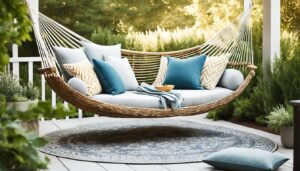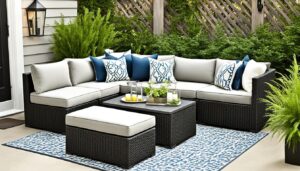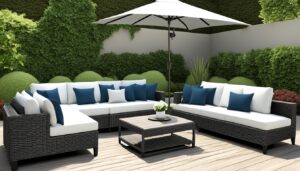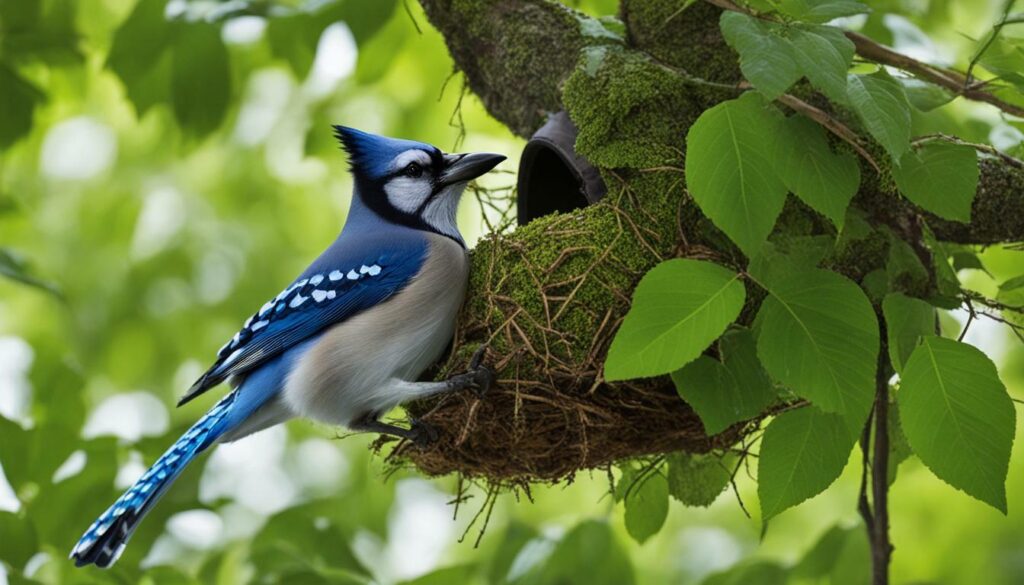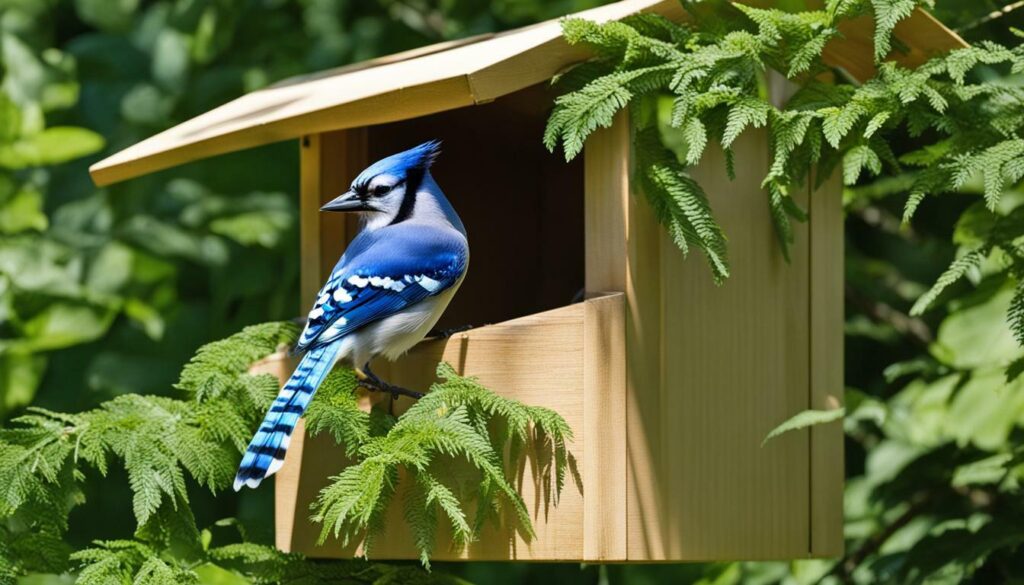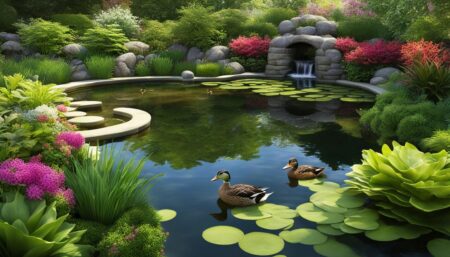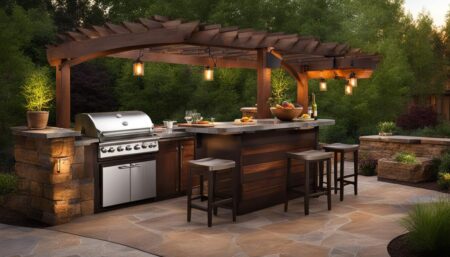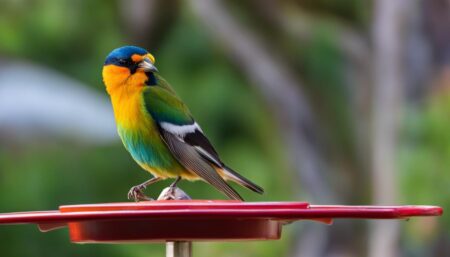Have you ever considered attracting blue jays to your backyard? These magnificent birds are known for their vibrant blue feathers and distinctive calls, and providing them with a suitable nesting box can create a perfect home for them. In this section, we will explore the benefits of having a blue jay nesting box and how it can attract these beautiful birds to your outdoor space.
- Blue jays are delightful birds and providing them with a nesting box can create a perfect home for them.
- Having a blue jay nesting box in your backyard allows you to observe and appreciate these beautiful birds up close.
- Creating a welcoming environment for blue jays involves understanding their nesting habits and providing a safe space for them to breed.
- Building and maintaining a blue jay nesting box requires careful attention to detail, including choosing the right location and regular cleaning.
- By following the guidelines provided in this article, you can create a perfect home for blue jays and enjoy the beauty of birdwatching in your own backyard.
Why Blue Jays are a Delightful Addition to Your Backyard
Blue jays are stunning birds with their vibrant blue feathers, black-collared necks, and white faces. Their unique and distinctive calls also make them stand out in any backyard. But, what makes blue jays especially delightful is their intelligence and playful behavior. They enjoy playing games, hiding food, and even mimicking other bird calls.
Attracting blue jays to your backyard can be a rewarding experience, and providing them with a nesting box can help make it happen. Blue jays are known for their strong nesting instincts and prefer nesting in tree cavities. Unfortunately, urbanization has led to a decline in suitable nesting sites, making nesting boxes an important solution.
With a blue jay nesting box, you can attract these beautiful birds to your yard and enjoy their delightful antics.
Blue jays are magnificent birds known for their striking blue coloration and vibrant personalities. They are a common sight in North America and can easily be attracted to your backyard by providing a suitable nesting box or blue jay breeding box. Blue jays prefer to nest in tree cavities, but as urbanization increases, natural nesting sites are becoming scarce. This is where a nesting box for blue jays comes into play.
It is essential to provide a nesting box specifically designed for blue jays to ensure their breeding needs are met. These boxes should be made of untreated wood and have an entrance hole of about 2 inches in diameter to accommodate blue jays’ size. Additionally, it is crucial to place materials such as grass, leaves, or small twigs within the nesting box to create a cozy environment for these beautiful birds.
Providing a suitable nesting box for blue jays is not only an act of kindness, but it can also benefit your backyard. Blue jays are known for their bug-eating habits, and their presence can help control insect populations in your area.
Overall, a blue jay nesting box is an excellent addition to any backyard. It provides a safe and welcoming environment for these magnificent birds while also enhancing your birdwatching experience.
Designing the Perfect Blue Jay Nesting Box
Building a blue jay nesting box can be a fun and rewarding DIY project that will provide your feathered friends with a safe and comfortable home. Here are some step-by-step instructions to help you create the perfect blue jay nesting box:
- First, gather all the necessary materials, including a 1×6 inch plank of untreated wood, screws, a saw, drill, and a metal hole saw.
- Cut the wood into the following pieces: two 18-inch sections for the sides, one 6×6-inch section for the bottom, one 8×8-inch section for the back, and two 9×8-inch sections for the front and roof.
- Next, drill a 1.5-inch entrance hole using the metal hole saw on one of the 9×8-inch sections.
- Attach the sides, bottom, back, front, and roof with screws. Make sure the entrance hole is on the front piece and the roof overhangs on all sides.
- Finally, attach an eye hook to the top of the roof so that you can hang the nesting box securely in a suitable location.
By following these simple steps, you can build a blue jay nesting box that will provide a safe and cozy home for these beautiful birds.
The location of your blue jay nesting box is crucial for attracting these beautiful birds. The ideal placement is at least 10 feet off the ground and positioned away from direct sunlight to avoid excessive heat inside the box. It’s also important to ensure the box is sheltered from strong winds and protected from predators such as cats or squirrels.
It’s recommended to position the box facing north or east to avoid direct sunlight and prevent rainwater from entering the box. Blue jays prefer nesting boxes located in quiet, undisturbed areas such as the edge of forests or tree lines in open spaces.
When deciding on the location, ensure that there’s ample space around the box for the birds to fly in and out freely. It’s also advised to avoid placing the box too close to bird feeders or houses, as the increased traffic and noise can disturb the blue jays and affect their nesting habits.
Keep in mind that blue jays are territorial birds and may attack other birds or animals that come too close to their nesting box. Therefore, it’s essential to place the box in an area where these conflicts are unlikely to occur.
By following these guidelines and choosing the perfect location for your blue jay nesting box, you can create a safe and welcoming environment for these magnificent birds.
Providing a Safe and Welcoming Environment for Blue Jays
Creating a suitable habitat for blue jays is essential to keep them safe and thriving. Blue jays prefer habitats with deciduous trees, shrubs, and open spaces. They often visit gardens with berry bushes, bird feeders, and water sources. Providing a water source, such as a birdbath or a small pond, can also attract blue jays to your yard.
It’s important to note that blue jays can be aggressive towards other birds, especially during the breeding season. To minimize conflict, ensure that the nesting box is at a safe distance from other birdhouses and feeders. Placing the nesting box at a height of 10-15 feet can also provide the blue jays with a sense of security.
Avoid using pesticides and herbicides in your garden, as they can harm the blue jays and their prey. Native plants that provide food, nesting sites, and shelter are ideal for creating a welcoming environment for blue jays. You can seek advice from a local nursery or a gardening expert on choosing the right plants for your garden.
Creating a Safe Nesting Environment for Blue Jays
Blue jays prefer nesting boxes made of natural materials, such as wood or bark. Design the nesting box with a predator guard to prevent other animals from accessing the eggs or chicks. A sloping roof can also provide additional protection from rain and predators. Ensure that the nesting box has proper ventilation and drainage to prevent mold and moisture build-up.
Regularly check the nesting box for any signs of damage or wear and tear. Replace the nesting material after each brood to maintain hygiene and prevent parasites.
Maintaining Your Blue Jay Nesting Box
Regular maintenance will not only keep your blue jay nesting box in good condition but also ensure that it remains a desirable location for blue jays to nest in. Follow these tips to maintain your blue jay nesting box:
- Inspect: Check the nesting box regularly for any signs of wear or damage. Repair any issues promptly to prevent further damage.
- Clean: After the nesting season, clean out the nesting box to remove any debris or parasites that may have accumulated. Use a scrub brush and mild soap solution to remove any stubborn dirt or stains.
- Reposition: If you notice that your blue jay nesting box is not being used or has been abandoned, try repositioning it to a different location. Blue jays may prefer a different orientation or height of the box.
- Keep it Safe: Make sure your nesting box is secured and cannot be easily dislodged by wind or predators. Check for loose screws or nails and tighten as necessary.
By following these simple steps, you can ensure the longevity of your blue jay nesting box and provide a safe and comfortable home for blue jays to raise their young.
“Regular maintenance is essential to keep your blue jay nesting box in good condition.”
The Joys of Blue Jay Birdwatching
One of the most delightful experiences you can have as a bird enthusiast is observing bluejays in their natural habitat. These majestic birds are known for their vibrant blue feathers, distinctive call, and playful personalities.
By providing a blue jay nesting box in your backyard, you can attract these beautiful creatures to create a home right at your doorstep. Imagine waking up in the morning to the soothing sound of chirping blue jays outside your window or watching them flit and flutter about as they gather nesting materials and feed their young.
Not only is blue jay birdwatching enjoyable, but it can also be educational. You can observe their behavior up close and learn about their nesting habits, feeding preferences, and social interactions.
With a blue jay nesting box, you can enhance your birdwatching experience and create a welcoming environment for these magnificent birds. So why not add a birdhouse for blue jays to your backyard and enjoy the wonders of birdwatching right at home?
Frequently Asked Questions about Blue Jay Nesting Boxes
You may have some questions if you are considering setting up a blue jay nesting box in your backyard. Here, we will answer some frequently asked questions to help you make informed decisions.
Q: What materials should I use to build a blue jay nesting box?
A: The nesting box should be made of untreated wood, such as cedar, pine, or fir. Avoid pressure-treated wood as it contains harmful chemicals that can harm the birds.
Q: How big should the nesting box be?
A: The nesting box should be at least 8 inches wide, 8 inches deep, and 12 inches tall. It should have an entrance hole of 1.5 inches in diameter.
Q: What is the best location for a blue jay nesting box?
A: The nesting box should be placed in a quiet, sheltered location, away from direct sunlight and wind. It should be elevated about 10 feet off the ground and facing northeast, east, or southeast.
Q: How do I maintain the nesting box?
A: The nesting box should be cleaned out at least once a year, preferably in the fall. Remove any old nesting materials and debris and scrub the box with a bleach solution (1 part bleach to 9 parts water). Rinse thoroughly and let it dry completely before adding new nesting materials.
A: It may take a few weeks or even months for blue jays to discover and start using the nesting box. Be patient and keep it well-maintained to increase the chances of attracting these birds.
Q: Can other birds use the blue jay nesting box?
A: Yes, other cavity-nesting birds such as chickadees, nuthatches, and some woodpeckers may also use the blue jay nesting box.
Q: Is it legal to have a blue jay nesting box?
A: Yes, it is legal to have a blue jay nesting box in your backyard. Blue jays are not considered endangered or threatened species.
By providing a suitable nesting box for blue jays, you can help these birds thrive and add beauty to your backyard. Use these tips and guidelines to create a welcoming environment for these magnificent creatures.
Blue Jay Nesting Box Success Stories
There is nothing quite like witnessing the beauty and majesty of blue jays in your backyard. With a blue jay nesting box, you can attract these magnificent birds and provide them with a safe and comfortable home.
Here are some success stories from individuals who have successfully attracted blue jays to their nesting boxes:
- “I built a blue jay nesting box in my backyard and within a few weeks, a pair of blue jays moved in. It was amazing to watch them build their nest and raise their young. The box has become a permanent fixture in my backyard, and I look forward to seeing the blue jays return each year.” – John D.
- “After years of unsuccessful attempts at attracting blue jays with other birdhouses, I decided to try a nesting box specifically designed for them. It worked like a charm! Now, I have a thriving blue jay population in my backyard and enjoy watching them feed and interact with each other.” – Susan T.
- “I was hesitant to build a blue jay nesting box at first, but after reading about the benefits, I decided to give it a try. I was amazed at how quickly the blue jays moved in and made it their home. Not only did it provide a safe nesting environment, but it also added to the beauty and diversity of my backyard.” – Michael K.
These success stories prove that a blue jay nesting box can make a positive impact on your backyard and the environment. With a little effort and the right techniques, you too can enjoy the wonders of blue jays nesting in your backyard.
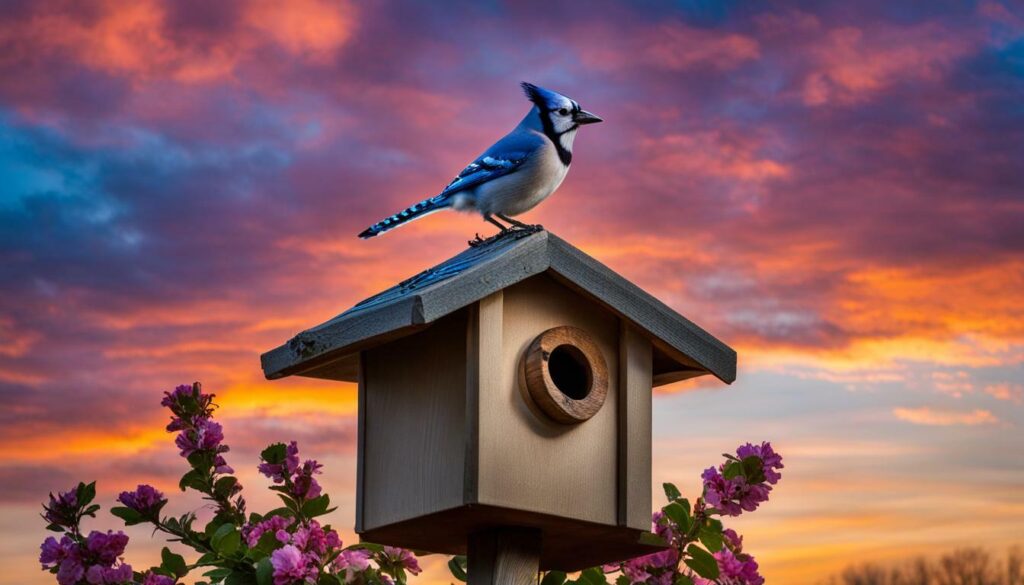
By providing a blue jay nesting box in your backyard, you can create a perfect home for these beautiful birds while enjoying the benefits of birdwatching. Blue jays are a delightful addition to any backyard, with their vibrant blue feathers and distinctive calls.
It is essential to provide a suitable nesting box for blue jays to nest and breed, as suitable nesting sites become scarce due to urbanization. When designing a blue jay nesting box, ensure it meets the specific needs of these birds, and place it in an ideal location that attracts them while ensuring their safety and comfort.
Regular maintenance of your blue jay nesting box is crucial to keep it in good condition and ensure the longevity of its use. You can enhance your backyard environment by providing a safe and welcoming habitat for blue jays, encouraging them to stay and nest in your nesting box.
Birdwatching can be a relaxing and fulfilling activity, and a blue jay nesting box can enhance your experience by attracting these wonderful birds to your backyard. By following the guidelines and insights provided in this article, you can create your own blue jay haven and enjoy the wonders of nature right at your doorstep.
Happy Birdwatching!
FAQ
Are blue jay nesting boxes effective in attracting blue jays to my backyard?
Yes, blue jay nesting boxes are designed specifically to attract blue jays to your backyard. These birds are naturally attracted to suitable nesting sites, and a well-placed nesting box can provide them with the perfect home.
How do I know if a blue jay nesting box is suitable for blue jays?
A suitable blue jay nesting box should have specific dimensions and features to accommodate blue jay breeding needs. It should also be made from durable materials that can withstand various weather conditions.
Can I purchase a blue jay nesting box or should I build one myself?
You can either purchase a pre-made blue jay nesting box from a reputable supplier or build one yourself as a DIY project. Both options can be effective in attracting blue jays, as long as the nesting box meets the necessary requirements.
Where should I place my blue jay nesting box?
The ideal placement for a blue jay nesting box is in a quiet and relatively undisturbed area of your backyard, preferably near trees or shrubs. It should also be placed at a height of around 10-15 feet above the ground.
How do I maintain my blue jay nesting box?
Regular maintenance is important to keep your blue jay nesting box in good condition. You should clean it out annually, preferably during late winter or early spring, to remove old nesting materials and prevent the buildup of parasites.
Can blue jays become aggressive towards humans?
Blue jays are generally not aggressive toward humans unless they feel threatened or provoked. It’s important to give them space and avoid interfering with their nesting activities to ensure a peaceful coexistence.
What can I do to attract blue jays to my nesting box?
To attract blue jays to your nesting box, you can provide them with a suitable habitat by planting native trees and shrubs, offering a variety of food sources such as nuts and seeds, and providing a water source like a birdbath.
How long does it take for blue jays to use a nesting box?
Blue jays may take some time to discover and feel comfortable using a new nesting box. It can vary depending on the availability of natural nesting sites and the attractiveness of your nesting box. Patience is key as they explore their options.
